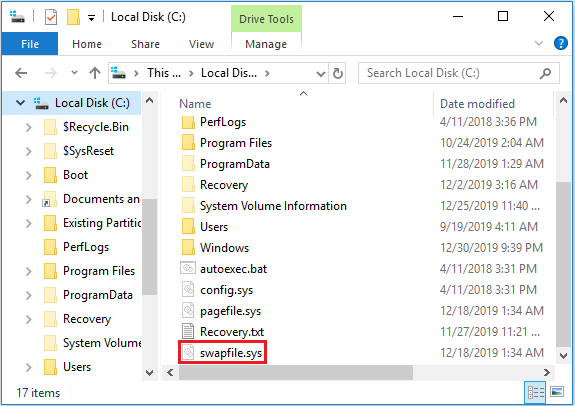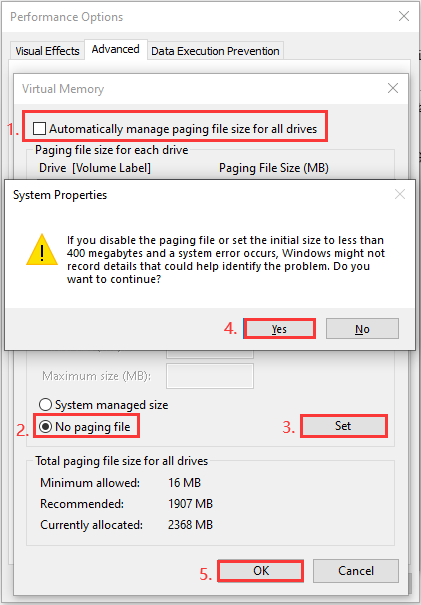What is swapfile.sys and what can it do with it enabled? If you don’t know, then you are in the right place. Not only can this post from MiniTool answer these two questions, but also tell you how to disable swapfile.sys.
What Is Swapfile.sys?
There is a new virtual memory file called swapfile.sys on Windows 10/8, which is similar to pagefile.sys. It is located in the C:\ drive. Swapfile.sys takes advantage of space on your hard disk when your RAM is filled up. Then you may be wondering why do I need a swap file when I already have a page file?

The swap file is used to handle modern Windows applications (the kind downloaded from the Windows Store), moving them to the hard drive in some kind of hibernation state when not in use.
However, the page file takes individual pages (4KB in size) of a process and moves them back and forth as needed. The page file and the swap file are used in combination, therefore, disabling the page file without editing the registry will also disable the swap file.
What Does Swapfile.sys Do When It Is Enabled?
If your computer possesses 2GB of RAM (the minimum recommended amount of RAM for 64-bit Windows 10) and if you are a multitasker, then the RAM will be filled up pretty quickly, and you need free RAM to keep your computer running smoothly.
It is not a bad thing to use all your RAM, but it is troublesome when there is no RAM leftover for incoming processes.
If you try to access an application that is currently residing in a swap file and there is not enough space in RAM, another process in RAM will be swapped to make room for the application you want to use. Swapfile.sys works in conjunction with pagefile.sys to help free up RAM.
What Happens When Swapfile.sys Is Disabled?
Without the swap file, some modern Windows applications will not work, while others may run for a while before they crash.
Failure to enable swapfile.sys or pagefile.sys will cause your RAM to work inefficiently because it does not have an “emergency backup” If the application has a 2GB memory footprint, it will remain in your RAM regardless of whether the footprint has been fully used.
When your RAM is full and there are no files on the hard drive to move, it will begin to cannibalize itself, which can cause applications running well to malfunction. At this point, you may see a crash.
How Do I Disable Swapfile.sys?
But if you do want to disable swapfile.sys, then how to do? You can disable it in Control Panel. And you will also disable pagefile.sys using this method. Here is a quick guide:
Step 1: Type control panel in the Search bar and then click Control Panel.
Step 2: Set View by: Small icons and then click System.
Step 3: Click Advanced system settings in the left panel. In the new window, go to the Advanced tab and then click Settings… in the Performance section.

Step 4: Go to the Advanced tab in the Performance Options window, and then click Change….
Step 5: In the Virtual Memory window, uncheck the box next to Automatically manage paging file size for all drives, select No paging file and click Set. Click Yes and OK to save changes.

Step 6: Restart your computer and then both swapfile.sys and pagefile.sys will disappear.
How to Disable Swapfile.sys Without Disabling Pagefile.sys?
Then how to disable swapfile.sys without disabling pagefile.sys? You need to do this by editing Registry Editor. Here is the tutorial:
Step 1: Press the Win + R keys to open the Run box, type regedit in the box and click OK to open Registry Editor.
Step 2: Navigate to the following path:
Computer\HKEY_LOCAL_MACHINE\SYSTEM\CurrentControlSet\Control\Session Manager\Memory Management.
Step 3: With the Memory Management is selected, right-click any blank area in the right panel to choose New > DWORD (32-bit) and name it SwapfileControl. Then press Enter.

Step 4: Restart your computer and you can find that only swapfile.sys disappears.
Final Words
Swapfile.sys is useful on Windows 10, and disabling it can cause troubles, so it is not recommended to disable it. But if you want to disable it, then you can try the methods mentioned in this post.
